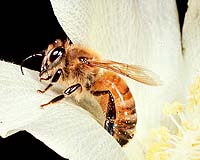 |
York, UK (SPX) Jan 20, 2010 Plant scientists at the University of York have published the first genetic map of the medicinal herb Artemisia annua. The map is being used to accelerate plant breeding of Artemisia and rapidly develop the species into a high-yielding crop. This development is urgently needed to help meet escalating demand for effective malaria treatments. Though preventable and treatable, malaria is a serious global health problem, estimated to kill almost a million people every year. The most effective drugs for treating malaria are Artemisinin Combination Therapies (ACTs). Increased funding for malaria treatments means demand for ACTs is expected to double from last year's figures, to around 200 million treatments, by 2012. However, meeting this increased demand will be a challenge: artemisinin is extracted from the plant Artemisia annua, but yields are low, making production expensive. In recent years, Artemisia production has been uneconomic and planting areas have declined, raising fears of shortages. Plant scientists at the Centre for Novel Agricultural Products (CNAP) in the Department of Biology at the University of York are addressing this problem by using molecular technologies to rapidly improve the Artemisia crop. In the latest issue of Science, they publish the first genetic map of this species, plotting the location on the plant's genome of genes, traits and markers associated with high performance. This will enable scientists to recognise young plants as high performers from their genetics. It will also inform the selection of suitable parent plants for breeding experiments. The map has been validated in glasshouse experiments that found the top-performing plants had elevated frequencies of genetic indicators for high yield. The project is led by Professor Dianna Bowles and Professor Ian Graham. Professor Graham says "The map is already proving to be an essential tool for us. With our new understanding of Artemisia genetics, we can produce improved, non-GM varieties of Artemisia much faster than would otherwise be possible." This speed is essential. "We intend to get high-yielding seed to farmers in the next 2-3 years in order to supply soaring demand for malaria treatments" explains Professor Dianna Bowles. "This is a really tight deadline and we can only do it with the benefit of the new knowledge provided by the map." The work demonstrates how modern genetics is shortening the timescales needed to turn a wild plant species into a domesticated crop. The scientists at York are creating the new varieties for use by many thousands of small scale growers in the developing world, for whom the Artemisia crop is an important source of income. The project has just received its second grant from the Bill and Melinda Gates Foundation. This grant will support final development of the new varieties and their delivery to Artemisia producers in Africa and Asia.
Share This Article With Planet Earth
Related Links University of York Farming Today - Suppliers and Technology
 Making a buzz: French roads to help honey bees
Making a buzz: French roads to help honey beesParis (AFP) Jan 19, 2010 France is to sow nectar-bearing flowers on the sides of roads in an experiment aimed at helping the honey bee, hit by an alarming worldwide decline, the ministry of sustainable development said on Tuesday. More than 250 kilometres (155 miles) of roadside will be sown in the coming months, launching a three-year test that could be extended to the country's 12,000-kilometer (7,500-mile) networ ... read more |
|
| The content herein, unless otherwise known to be public domain, are Copyright 1995-2009 - SpaceDaily. AFP and UPI Wire Stories are copyright Agence France-Presse and United Press International. ESA Portal Reports are copyright European Space Agency. All NASA sourced material is public domain. Additional copyrights may apply in whole or part to other bona fide parties. Advertising does not imply endorsement,agreement or approval of any opinions, statements or information provided by SpaceDaily on any Web page published or hosted by SpaceDaily. Privacy Statement |